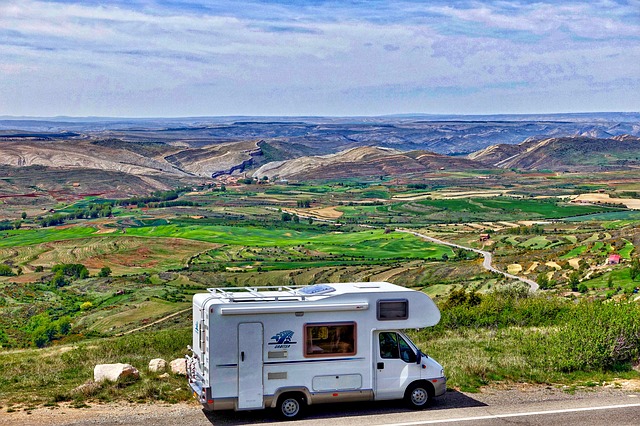
Walmart is a great option for RV batteries for several reasons. For one thing, if you need to replace a battery while you’re on the road, it’s easy to find a Walmart store. They also have a long list of available options, and you can check online whether your deep cycle battery is in stock at your nearest store before making the trip.
What Are Deep Cycle Batteries?
Every RV comes equipped with two types of battery – a starter battery and deep-cycle house batteries.
Deep cycle batteries provide dependable power for everything inside your rig and are especially important for boondockers who spend time off-grid! These batteries are designed to power your lights, water pump, and appliances such as your RV air conditioner, microwave, and cooktop.
Deep cycle batteries are fully discharged before they are recharged again. That process is known as deep cycling. Knowing the different types of deep-cycle batteries is important to ensure you choose the right one for your RV. They fall into four categories: Lithium-ion, AGM, gel, and Flooded lead acid.
Types of Deep Cycle Batteries:
- Lithium-ion
- Flooded lead-acid
- Gel
- Absorbed glass mat (AGM)
#1- Lithium Ion
If you’re using large appliances in your rig, a lithium-ion battery should be top on your list. Being able to use power and recharge quickly is key if you’re doing any cooking, TV streaming, or running A/C in your RV. It is the most expensive option, for several reasons.
Lithium-ion batteries can accept extremely fast charge rates, charging at about a 5x faster rate than most AGM batteries. They are extremely lightweight and compact, can be completely discharged with no damage, and require no maintenance. Lithium-ion batteries also have the longest lifespan of all deep-cycle batteries, lasting upwards of 2,000-5,000 cycles. They can be recharged in about an hour when completely dead and have no discharge memory, so they are almost 100% efficient. These are one of the most expensive battery options.
#2- Flooded Lead-Acid
Flooded lead-acid batteries are made of lead plates that have been submerged in a liquid electrolyte, which is why they are referred to as “flooded”. They are the most popular option. These are the least expensive of all deep-cycle RV batteries, although they are super heavy, have a low usability capacity, and are prone to overheating. Flooded lead-acid batteries require regular maintenance and will most likely require a monthly top-off of electrolytes. These batteries also release hydrogen, a poisonous gas, while being charged. They must be frequently cleaned to remove any corrosive battery acid. Dealing with flooded batteries can be dangerous if they leak, crack, or tip over, so handle them with caution. They must be stored fully charged and kept out of freezing temperatures. Despite the many disadvantages, flooded lead-acid batteries are pretty tolerant of overcharging and have an indefinite shelf life if maintained properly.
#3- Gel
Flooded lead-acid batteries have some disadvantages, and gel batteries were created to try to combat some of those problems. The electrolyte in this battery is gelled, making spills less likely and preventing off-gas from regular use. Gel batteries require no maintenance and have a decent charge efficiency, but keep in mind that like AGM batteries, these can also be ruined if overcharged.
You’ll need a specific charging profile for gel batteries. Always remember — charge low and slow!
#4- Absorbed Glass Mat (AGM)
AGM RV batteries, a.k.a. absorbed glass mat batteries, were designed to withstand large vibrations and extreme weather. AGM batteries are made of fiberglass mats that hold the liquid electrolyte in place. They’re spill-free batteries and they can be mounted sideways or any other way you need. This makes them ideal for those who are trying to squeeze several batteries into a small or awkward space. Unlike lithium-ion batteries, AGM batteries are not affected by freezing temperatures. They require no maintenance, can be discharged up to 80%, and are extremely durable. Absorbed glass mat batteries are best used for shorter periods off the grid as they have a shorter lifespan. Be extra careful not to overcharge, as these batteries can be easily damaged. These batteries are more expensive than flooded lead-acid and gel batteries.
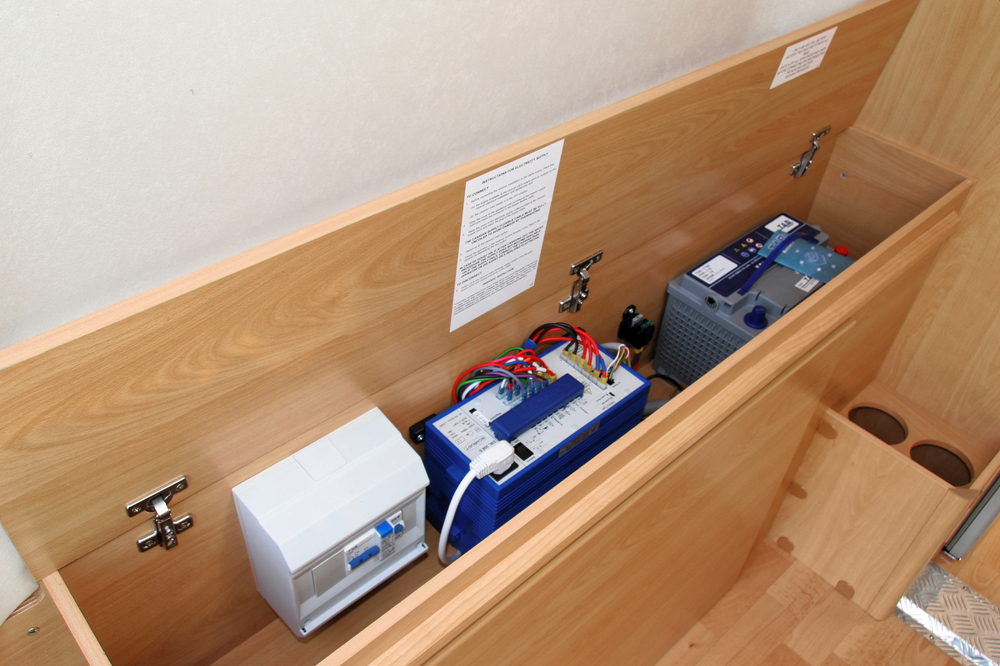
Marine batteries
RV marine batteries are a hybrid of your starting battery and your deep cycle battery, but most people recommend them only as deep cycle batteries. They’re less expensive than a dedicated deep-cycle battery, but not necessarily as good quality.
Most RV batteries bathe the lead in an acid and water solution, which you need to fill up every so often because, with every charge, the battery loses a little of the solution. To fix this problem and have maintenance-free batteries, manufacturers sealed the batteries completely and just left a small vent on the side.
Generally, RV batteries and marine batteries are interchangeable. Just make sure your marine battery has a larger reserve capacity and a slow discharge. Also, check that your marine battery has enough reserve to power your RV and everything you want to use inside it between charges.
Three Types of Marine/RV Batteries
There are three different types of RV marine batteries available – flooded batteries, gel batteries, and AGM batteries. Flooded batteries use sulfuric acid and lead plates. Gel batteries are sensitive to overcharging and are usually not preferred by boaters. AGM batteries use glass mat separators, are maintenance-free, and aren’t affected by shock or vibrations
7 Best RV Batteries at Walmart
You can buy a variety of RV batteries at Walmart, including lead-acid and AGM batteries.
RV batteries at Walmart
Here are some of the best options for Walmart RV batteries.
1.) EverStart Lead-Acid Marine/RV Battery Group 24DC
Most EverStart users love this brand and say it is long-lasting and powers well. Group 24 indicates that this battery is slightly smaller than the group 27 or 29 batteries listed below, meaning it fits into a smaller space and is lighter than bigger batteries. However, it also doesn’t offer as much charge. The standard lead-acid design means it offers good amp hours and power, but not the very best.
2.) EverStart Lead-Acid Marine/RV Battery Group 27DC
Yep, there’s a theme here. EverStart users really love these batteries. If you want something with more power than a small group 24 battery, but not as big and bulky as a group 29, this is the Goldilocks of the group.
3.) EverStart Lead Acid Marine Battery, Group 29DC
This EverStart lead-acid battery – the largest on our list – gives you more power for longer periods. It is maintenance-free and has great cycling and recharge capabilities. Reviewers say the battery is reliable and lasts a long time. It comes with a one-year warranty.
4.) VMAX SLR100 AGM Deep Cycle Battery
This is a serious battery. It’s made with military-grade materials, is fast-charging, and has a very low self-discharge rate. It’s maintenance-free, heat and weather-resistant, and doesn’t emit any toxic fumes.
5.) VMAX SLR155 AGM Deep Cycle Battery (Set Of 2)
VMAX is known for high-quality AGM deep-cycle batteries. These come with a one-year warranty and promise a 10-12 year lifespan in float mode. These two batteries have a total of 310 AH of power, making them a good option for storing power from solar panels. They are fast-charging, maintenance-free, and don’t emit any toxic fumes. They are considerably more expensive than the lead-acid batteries we featured above, however.
6.) Mighty Max 35AH Deep Cycle AGM Battery
This deep-cycle solar battery has a long service life and performs well in both high and low temperatures. It comes with a one-year warranty. It’s maintenance-free and has deep discharge recovery abilities. It also resists shocks and vibrations. Since this is a small battery, with just 35AH, you’ll need several to power your RV.
7.) Mighty Max 100AH Deep Cycle AGM Battery
This AGM battery has all the great properties of the above one but with almost 3x the amp hours. It still has the advantage that all AGM batteries do over lead-acid batteries – you won’t have to monitor and refill the water level. So it’s maintenance-free, long-lasting, and has great deep discharge recovery properties.

How to Get the Most out of Your Deep Cycle Battery
There are a few things you can do to maximize the lifespan of your deep-cycle battery. Cycle the battery down to 50% discharge before recharging it every time, instead of recharging the battery when it’s down to 20% of its charge. The sooner you can recharge your deep-cycle RV battery, the better.
On the flip side, you don’t want to undercharge your battery. Charge your battery to 100% before unplugging it and using it again. Undercharging can also age your RV deep cycle battery and causes sulfation. This happens when the sulfate material crystalizes on the discharged portions of the battery plates and renders them useless. There are a few ways to check the charge of your battery. You can shell out a few hundred bucks for a meter to measure the charge or use a digital display to see the battery voltage.
Buying a Deep Cycle RV Battery
Your goal, of course, is to get the most power for the least cost when buying your deep-cycle RV battery. Power for these batteries is measured in either amp-hours (AH) or reserve capacity (RC). AH refers to how many amps the battery will put out over 20 hours, and RC refers to how many minutes the battery can support a 20-amp output. A battery with a larger AH or RC rating has more capacity than a smaller one.
Generally speaking, the larger the size of a deep-cycle RV battery, the greater the AH and RV, and the more power they have. Keep in mind, you can also join batteries together and wire them in parallel to get more amp hours, but keep the voltage the same.
What to look for:
- Capacity – Your battery’s capacity will be measured in AH, or ampere hours. Ampere hours measure the amount of current the battery can deliver over a certain period of time. A higher AH means your battery can store more power and work longer. Just remember this will affect the weight and size of your battery.
- Depth of discharge – This is usually a percentage that shows the specific amount of power discharged by the battery. If you’re going to use a lead-acid battery, know that the life cycle and depth of discharge are related. Deeper individual cycles also mean the battery will have fewer cycles overall.
- Voltage – The voltage refers to the potential electrical difference. In most cases, deep cycle and starter batteries have 12v DC (direct current). In some cases, RV owners combine 6v batteries in a series to build their own 12v batteries to use.
- Charging – How will your batteries be charged? Do you need a power inverter? Will you be using a generator, solar power, or shore power to charge your batteries?
- Temperature changes – How will your battery do in low and high temperatures? You’ll want one that can provide heat in winter and air in summer, so make sure it can withstand at least some temperature differences. Also, you may want to see how your battery does in humid conditions, if you’re visiting areas where that’s an issue.
- Ability to withstand vibration – You also want to investigate the overall quality of your battery. A good RV battery will be able to withstand shocks and vibrations so it’s not damaged in transit
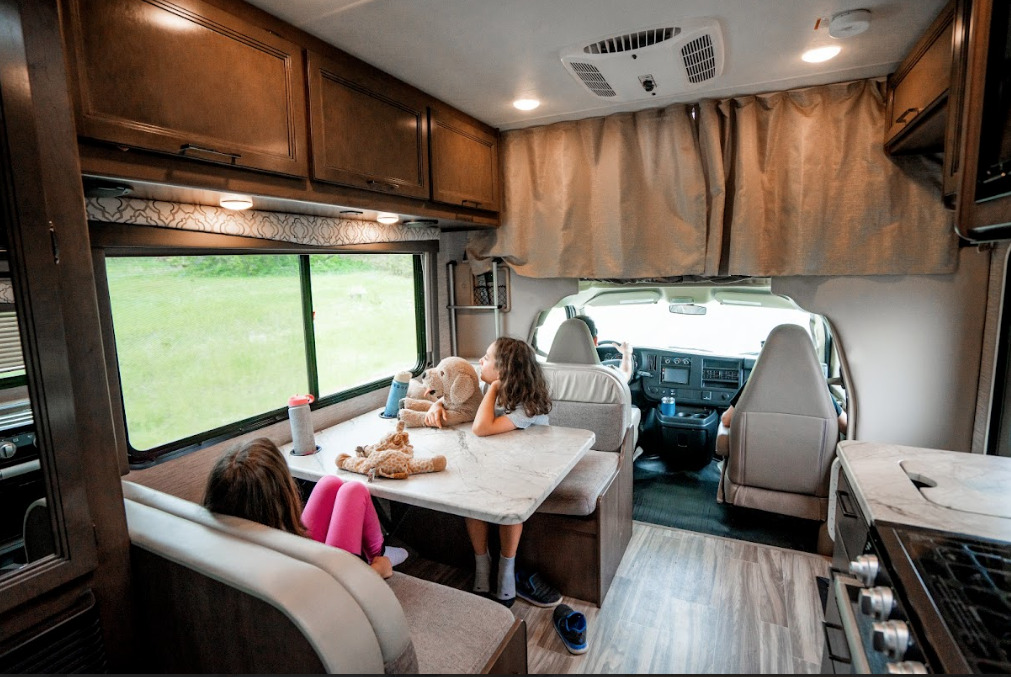
Maintenance Tips
- If using a flooded lead-acid battery, be sure to keep the water levels up (especially in warmer weather!)
- Remove the caps on your battery to check water levels frequently to ensure the battery plates are fully covered
- If your water level is low, fill with distilled water to the appropriate level
- To clean your batteries, put a teaspoon of baking soda in a cup of water, let it dissolve, and then spray it on the battery. This will bubble away the build-up. Use a hose to spray this off.
When disconnecting a battery, remove the negative charge first. When reconnecting, connect the positive terminal first. Battery capacity is reduced as temperatures fall. On a cold morning, don’t be shocked to find your battery dead. At -22 degrees Fahrenheit, battery capacity drops by 50%. Higher temperatures, like 122 degrees Fahrenheit, will increase battery capacity by 12%. A partially-discharged battery can freeze, but a fully-charged battery cannot.
If you can keep your battery charged during winter, then keep it in your rig. If not, disconnect it, and store it in a warm place, until you are ready to get back on the road again. Inactivity is not good for batteries. Do not buy new ones to save for later– if you do have to buy them before you are ready to use them, make sure to keep them charged!
Reasons to Switch to 6-Volt RV Batteries
If you do a lot of dry camping, you may find that you want to bump up your amp hours. For this reason, many people decide to switch from a single 12-volt battery to two (or more) 6-volt batteries which are linked in a series. This gives more amp hours. Additionally, 6-volt batteries can withstand a deeper discharge than their 12-volt counterparts. This is ideal for those who use battery power often.
Basic RV Battery Charger Options
If you want to buy or upgrade your battery charger, you need to know what’s best for your RV. There are eight main types of chargers that work well, and sometimes can even work in conjunction with one another.
- Converter-charger
- Inverter-charger
- Single and Multi-Stage Chargers
- Solar Power
- Wind Power
- Generators
- Trickle Chargers
- “Echo” Chargers
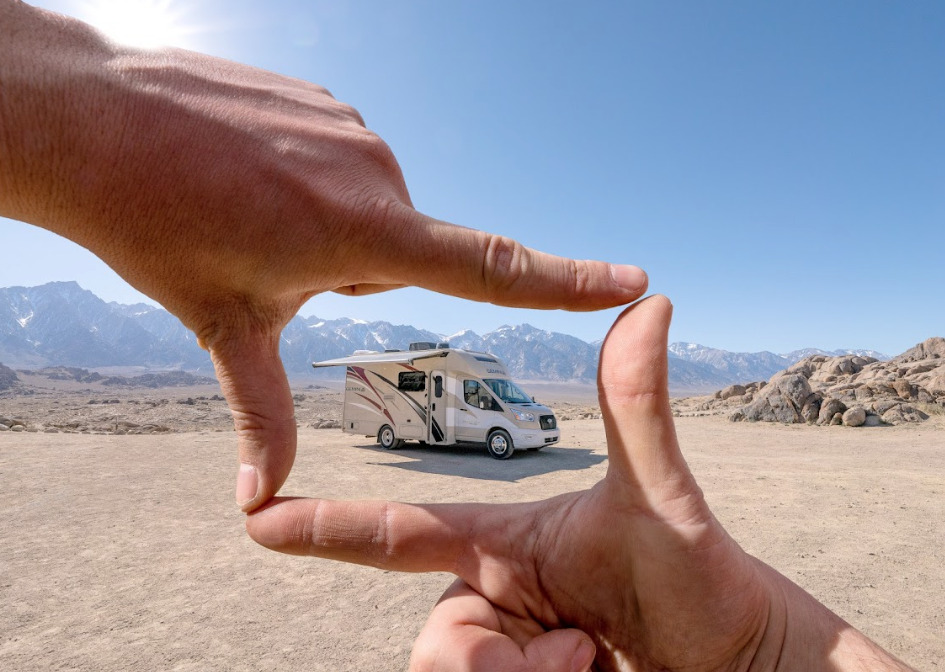
1. Converter-charger
This is one of the most basic RV charger/converter systems to convert 120v of shore power into 12V of DC power. Thanks to this, your battery will store energy while you are plugged in.
The converter charger is rated in amps. About 55 amps of DC can power up your RV lighting and appliances and even do some charging as well. These types of chargers interact with the main power distribution panel and offer both a 12v and 12v function in one unit. It comes both in single and multi-stage products.
2. Inverter-charger
This charger comes in a multi-stage format. It’s basically the same as the converter charger but it has the capability of producing 120 v AC from the 12v battery when you lack shore power. Well-known inverter charger brands include Magnum and Xantrex.
3. Single and Multi-Stage Chargers
Single Stage Charger
This type is found in a lot of motorhomes, especially old ones. But how does it work?
For starters, we can’t just compare a battery to a sponge. They don’t simply absorb amps and store them there indefinitely until they’re needed. A battery has to receive a higher voltage than its capacity to charge. Just think of it as a flat tire. As you try to inflate it you need to apply more air pressure to fill it up completely. If the pressure is weak, the tire will push it back out and it will deflate. So the battery starts to fill with amp-hours but pushes them back as they approach maximum capacity.
It’s called a “taper charge” when a fixed voltage is applied. You have a lot of amp flow at first but with constant charging of the battery, the rate decreases. This is the Single Stage method and it can be found in low and mid-range trailers and smaller motorhome battery chargers.
Multi-Stage Charger
If you want to aim for a more modern method, choose the multi-stage charger. This optimizes charging based on the three stages of the battery charge. These stages are Bulk, Absorption, and Float.
The bulk stage is when you charge the battery from a low charge to about 80% capacity. This will constantly charge the battery at 25% of the amp capacity. Of course, this is when the battery pushes back so the charger kicks in and increases the voltage to keep the amps at a constant rate.
When it reaches a certain level, it switches to the absorption stage. This is all about maintaining a constant flow of voltage (about 14.1v – 14.8v) to the battery till it reaches maximum charge capacity or until float mode switches on.
Float mode keeps the battery fully charged at 100% and maintains a voltage of 13.6. This also keeps the battery safe for a long time.
The multi-stage RV battery charger is better than the single-stage, but both work well when the battery is new and low on voltage. You can find a great multi-charger here.
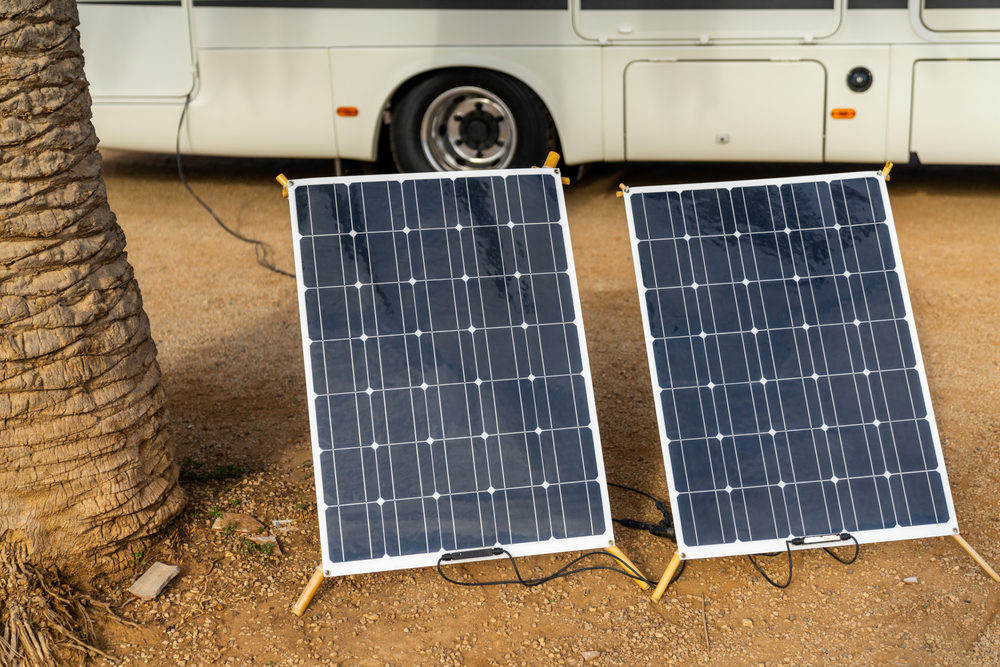
4. Solar battery Charger
A lot of people want innovative chargers that will supply power to their RVs almost indefinitely. RV Solar panels can be a great option in this situation.
Small solar panels of 15-20 watts can maintain battery power while it’s out of use. Meanwhile, a large solar panel of 100 – 150 watts can offer more than enough energy to fully power your RV and supply energy for the entire day.
If you go for a 14+ voltage you will cover 1 amp needed to power the battery while it’s in standby mode. This is great since most RVs lose about 0.25 amps per hour without any outside solicitations. Some small solar panels are wired directly to the battery.
Although they sound like a great option, solar panels take careful planning and a lot of components. You will need a professional to help you with installation. Make sure you do plenty of research if you opt for this type of charger.
5. Wind Chargers
Wind chargers are another eco-conscious option that may be right for you. You only need a propeller driving an alternator and the wind charger will provide energy.
Sadly, you likely can’t receive all the power you need through a wind turbine since they are usually small in size. However, if you camp in deserts or in mountain valleys where you can find an abundance of wind, then this charger can be a useful addition to your set-up.
6. Generators
Now, who needs chargers when you have your own generator? These can be bought from any store and produce enough energy to power an entire RV. They provide 120v of power and help the RV’s converter or inverter charger to recharge the battery.
You can find portable generators that have an output terminal that gives out direct current (DC). That current can be used to power the battery directly, but it might not be enough to charge it completely. Also, it is risky to power the battery directly from your generator, especially if you forget to turn it off when the charge is complete.
7. Trickle Chargers
The trickle charger is an RV Battery Charger or Maintainer that keeps the battery charged at 100%. It’s rather small and uses a single-stage unit. The best part is that due to the advancement of technology, the trickle charger has a float charge stage. The charger is set to hold a single 12v battery, but you may find multiple outputs in other models. Those models can handle two or more batteries at the same time without any problems.
If you want to purchase this type of charger, consider the Battery Minder or the Battery Tender.
8. “Echo” Chargers
Now, these are not exactly battery chargers. They are closer to a battery combiner that switches energy between batteries. This is a great option if your RV holds two types of batteries (preferably isolated from each other). The main charger is connected to the first battery while the combiner “echos” a portion of the charging amps to the second battery.
If you like to bring along a home battery this is an amazing way to charge the engine battery. This way you will have a backup battery for shore power and to charge the other when it starts to deploy. An amazing combiner is the Xantrex Echo Charger. If that doesn’t suit you, turn to the Ultra Trik-L-Start.
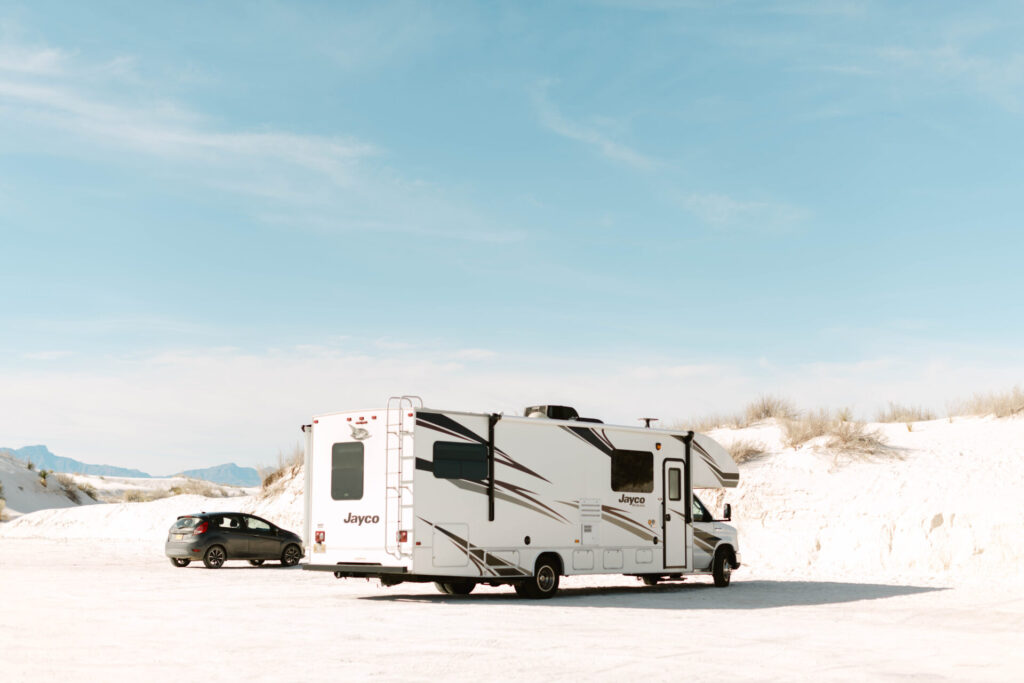
How To Make Sure Your Walmart Battery Is In Stock
As we mentioned above, you can check online to make sure your RV battery at Walmart is in stock. Find the battery on the Walmart website. Then click on “More delivery & pickup options.” This will allow you to select your location by using the zip code where you want to pick up the battery. You’ll get a list of nearby Walmarts and it will indicate whether your chosen battery is in stock at that store.
You can also try ordering your Walmart RV battery from the company’s website. The product page will indicate whether the battery can be shipped or must be picked up in-store. Walmart offers free, 2-day shipping on most orders of $35 or more, and they can ship just about anywhere in the U.S.
Does Walmart Install or Charge RV Batteries?
Walmart Auto Care Centers do install and charge batteries. You’ll want to make sure the Walmart where you buy your battery has an Auto Care Center, and you’ll want to check that they can work on your rig and with your particular batteries. Walmart Superstores often have Auto Care Centers, but you should check to be sure. You can find one using the Walmart Store Finder.
Can you camp in an RV overnight at Walmart?
Often, Walmart will allow RVs to park overnight for one night in their store parking lots. Permission for overnight camping varies from store to store, and the store manager is responsible for deciding whether you can camp. In other words – ask nicely. Also, stores are more likely to allow you to camp if you are spending money in the store. After a big purchase like a Walmart RV battery, you’re more likely to be allowed to stay there.
This post may contain affiliate links.

